The christian church is the symbol of christ, the abode in which all believers and non-believers may find refuge and solace. As a place for a specific action, a church must be ‘ functional’ as a monument ‘god’, it must inspire a sense of religion, as an expression of ‘man’, it must achieve artistic beauty. without any of these it cannot achieve religious significance.
![[filefield-description]](https://www.archinomy.com/wp-content/uploads/case-studies/2011/church-3.jpg)
![[filefield-description]](https://www.archinomy.com/wp-content/uploads/case-studies/2011/church-4.jpg)
CONTENTS
- Introduction
- St. stephens
- Cathedral church of redemption
- Central baptist church
- St. james church
- Christ church
- Sacred heart cathedral
CATHEDRAL CHURCH OF REDEMPTION![[filefield-description]](https://www.archinomy.com/wp-content/uploads/case-studies/2011/cathedral-church-of-redemption.jpg)
Location: The Cathedral Church of Redemption,
1 church Road, North Avenue, New Delhi.
Ownership: Public. Church of North India
Architect: Henry Alexander Nesbitt Medd
Status: Unprotected
State of Preservation: Good
Year of Completion: 1935
![[filefield-description]](https://www.archinomy.com/wp-content/uploads/case-studies/2011/cathedral-church-of-redemption-2.jpg)
![[filefield-description]](https://www.archinomy.com/wp-content/uploads/case-studies/2011/cathedral-church-of-redemption-3.jpg)
![[filefield-description]](https://www.archinomy.com/wp-content/uploads/case-studies/2011/site.jpg)
SITE
![[filefield-description]](https://www.archinomy.com/wp-content/uploads/case-studies/2011/site-2.jpg)
![[filefield-description]](https://www.archinomy.com/wp-content/uploads/case-studies/2011/site-3.jpg)
Directly next to the Viceroy’s House is the Church at the northern end of Brassey Avenue that leads out from the Jaipur column. The prominent site on an important town-planning axis led H.A.N.Medd to conceive a special architectural form. In general, every church is oriented to the east on its main axis.
HISTORY…
In 1922, after the war was over the Rev. T.R.Dixon serving as Chaplain found a small Anglican population worshipping in a Church (near Gole Post Office) which accommodated just about 60 people.
So the Chaplain of Raisina had convinced the appropriate Bishop of Lahore of the need for a Church in the close proximity to the Secretariats because this was where most of the members of congregation worked.
![[filefield-description]](https://www.archinomy.com/wp-content/uploads/case-studies/2011/cathedral-of-liver-pool.jpg)
![[filefield-description]](https://www.archinomy.com/wp-content/uploads/case-studies/2011/cathedral-of-liver-pool-2.jpg)
![[filefield-description]](https://www.archinomy.com/wp-content/uploads/case-studies/2011/cathedral-of-liver-pool-3.jpg)
Various sites were considered for the church with Herbert Baker pressing for the site in Ashoka Road (where now YWCA stands) and lutyens avocating for where now the church stands.
In 1925,Medd’s design was selected (through competetion) which reflected Palladio’s Redentore Church in Venice and Lutyens’ Free Church in 1910 at Hampstead Garden Suburb.
![[filefield-description]](https://www.archinomy.com/wp-content/uploads/case-studies/2011/redentore-church.jpg)
![[filefield-description]](https://www.archinomy.com/sites/default/files/case-studies/2011/free-church_.jpg)
![[filefield-description]](https://www.archinomy.com/wp-content/uploads/case-studies/2011/free-church-2.jpg)
Competition drawing by Medd in 1925
But as Lutyens was busy with the Viceroy’s house and lack of funds, construction of cathedral was kept on hold.
![[filefield-description]](https://www.archinomy.com/wp-content/uploads/case-studies/2011/revised-design.jpg)
![[filefield-description]](https://www.archinomy.com/wp-content/uploads/case-studies/2011/dome.jpg)
![[filefield-description]](https://www.archinomy.com/wp-content/uploads/case-studies/2011/plan-site.jpg)
![[filefield-description]](https://www.archinomy.com/wp-content/uploads/case-studies/2011/location-plan.jpg)
![[filefield-description]](https://www.archinomy.com/wp-content/uploads/case-studies/2011/st-marks.jpg)
- Porch
- Nave
- Aisle
- Choir box above
- Sanctuary
- Chapel
- Altar
- Pulpit
![[filefield-description]](https://www.archinomy.com/wp-content/uploads/case-studies/2011/st-marks-2.jpg)
SECTION..
The building has two consecutive domes.The drum sits over the central dome which then leads to another dome on top with lantern at the peak.
Light and ventilation is insufficient in the building through the openings.
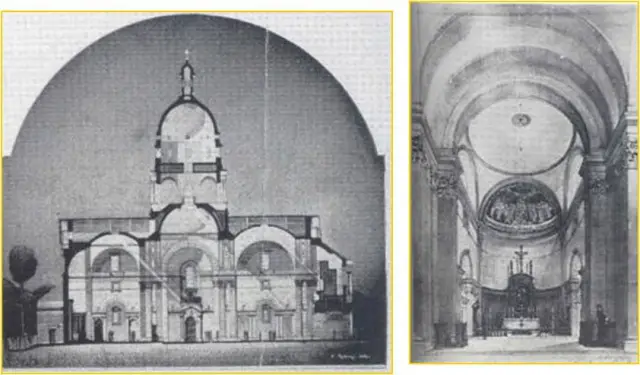
ELEVATION
FRONT
![[filefield-description]](https://www.archinomy.com/wp-content/uploads/case-studies/2009/elevation.jpg)
The side of the catholic cathedral was the most satisfying, with broad and simple flat areas of wall that recall the facade of Lutyens’ BMA building , London.
![[filefield-description]](https://www.archinomy.com/wp-content/uploads/case-studies/2011/domes.jpg)
1,2 The 2 consecutive domes
REAR

The most striking feature is the central high tower, to which the building rises in levels.In each side of the central tower is a pediment window.
The structure built in stone which is left untreated and this continuous rough appearance is broken by the decoration of arched doorways and the few windows with smoothened stone.
The horizontal bands, pediments and the dome clearly depicts borrowed classical revival (Florence Cathedral) .
STYLE…
The style of the church may be said to be that of the English Renaissance while the plan owes its origin to Palladio’s great church in Venice. Various elements of Classical Architectural Style have been brought together in a composition which fits in to the Indian scenario.
![[filefield-description]](https://www.archinomy.com/wp-content/uploads/case-studies/2011/style.jpg)
This is a typical Greek pediment which is being used to highlight doorways.
![[filefield-description]](https://www.archinomy.com/wp-content/uploads/case-studies/2011/fluted-pilasters.jpg)
Fluted pilasters borrowed from the Renaissance.
![[filefield-description]](https://www.archinomy.com/wp-content/uploads/case-studies/2011/tinted-glass.jpg)
There is a tinted glass window that enhances the ethereal beauty of the church.
![[filefield-description]](https://www.archinomy.com/wp-content/uploads/case-studies/2011/indo-sarsenic.jpg)
The railing speak of the Indo-Sarsenic quality that the church has.
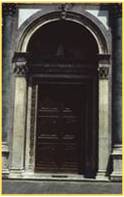
Renaissance Archway
![[filefield-description]](https://www.archinomy.com/wp-content/uploads/case-studies/2011/decorations-and-carving.jpg)
Decorations and carving reflect Indian architecture
THE DOME…
Medd left India during the process of construction. The dome was much later, added on by Lutyens.
![[filefield-description]](https://www.archinomy.com/wp-content/uploads/case-studies/2011/dome.jpg)
Dome Viewed Internally…
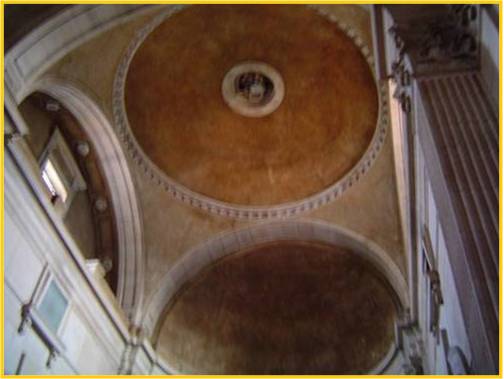
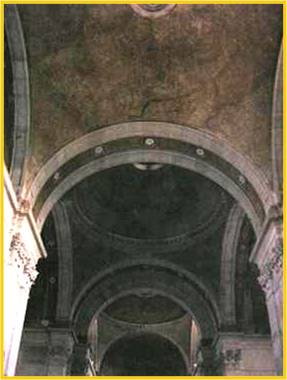
The internal height and thick walls contribute to the cool temperature that is maintained inside.
VAULTING SYSTEM…
The two main vaulting systems used in this church are:
- Cross vault
- Barrel vault
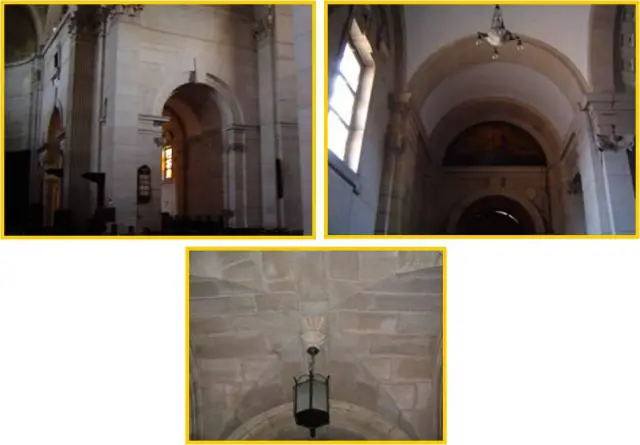
ARCHES…
The external arches over the doorways are semicircular, while those on the windows are flat and enhanced with large keystones and voussiors.
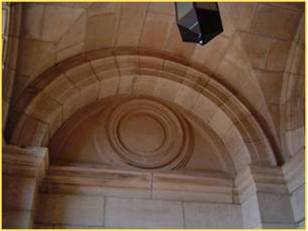
The internal arches are not as well decorated.
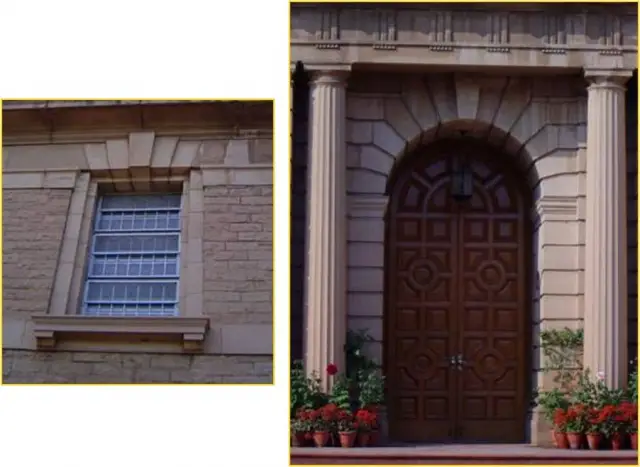
ORDERS / COLUMNS :
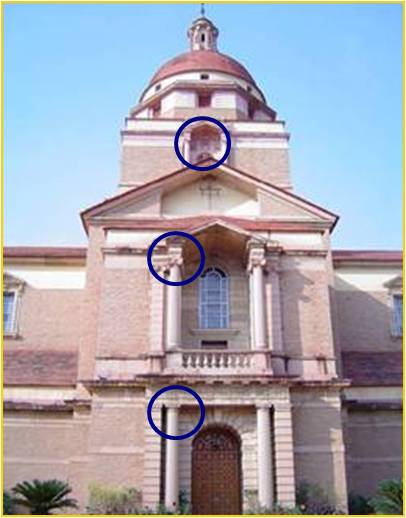
All the three orders are used in the elevation.
![[filefield-description]](https://www.archinomy.com/wp-content/uploads/case-studies/2011/colums.jpg)
Doric Ionic Corinthian
MATERIALS AND CONSTRUCTION :
The material used in the interiors is white Dhoulpur sandstone, which with its red variety is used in many of the main buildings in Lutyens’ Delhi.
The high altar is of white marble with coloured inlay and the floor of the sanctuary is of various Indian marbles.
Ashlar stone, initially meant to be used throughout the building, was eventually used only at the four porches and at moulded courses, the rest of the building in plastered brick.
- The walls are made of brick masonry and stone.
- The floors are made of stone
- The roof is coffered.
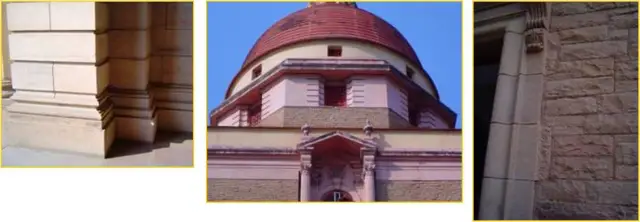
INTERIORS…
The Bishop’s chair designed by the architect still exists on paper in the final design, the present one is considered temporary.
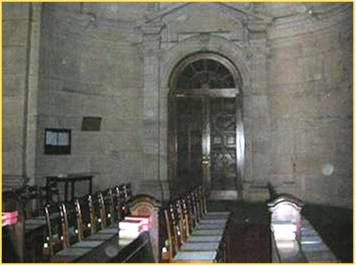
The clergy seats and prayer desks were made from gifts by the congregation of the church of India, Burma and Ceylon.
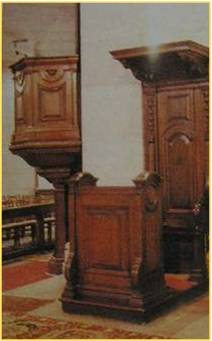
MAIN NAVE…
The church is not much of historical importance but has delightful interiors that are a treat for its visitors.
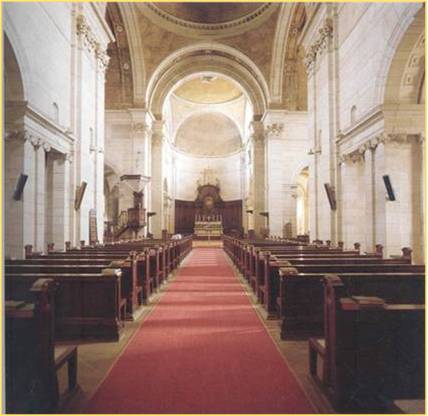
It has been so built that heat is kept off even when summer is in its prime and the place remains cool and calm as sunlight peeps into the church through small and recessed openings, placed strategically.
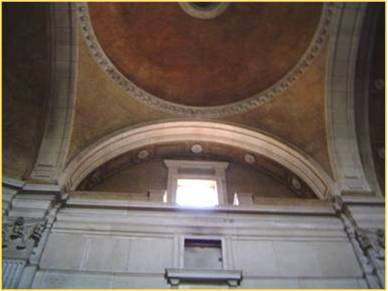
The windows and light openings are placed high above ones reach.
![[filefield-description]](https://www.archinomy.com/wp-content/uploads/case-studies/2011/fine-organ.jpg)
The Church also houses a fine organ and a silver-cross, which was donated to the Church by Irwin.
![[filefield-description]](https://www.archinomy.com/wp-content/uploads/case-studies/2011/high-altar.jpg)
The high Altar, on which stands a silver cross gifted to the Cathedral by King George V, still stands there among the flower vases and candlesticks, four of which were gifted by the Lady Grimthrope and the ladies of Yorkshire.
![[filefield-description]](https://www.archinomy.com/wp-content/uploads/case-studies/2011/light-quality.jpg)
The quality of light in side the Church is dim, especially when the doors are closed.
![[filefield-description]](https://www.archinomy.com/wp-content/uploads/case-studies/2011/light-quality-2.jpg)
CONCLUSION…
Although the Church does not have a long or interesting historical background, its presence on the major town planning axes of the Lutyen’s Delhi makes it very important. The variety and mixture of classical western architecture composed with Indian materials and some Indian elements gives a very different feel to the Church.
![[filefield-description]](https://www.archinomy.com/wp-content/uploads/case-studies/2011/conclusion.jpg)
ST. STEPHEN’S CHURCH
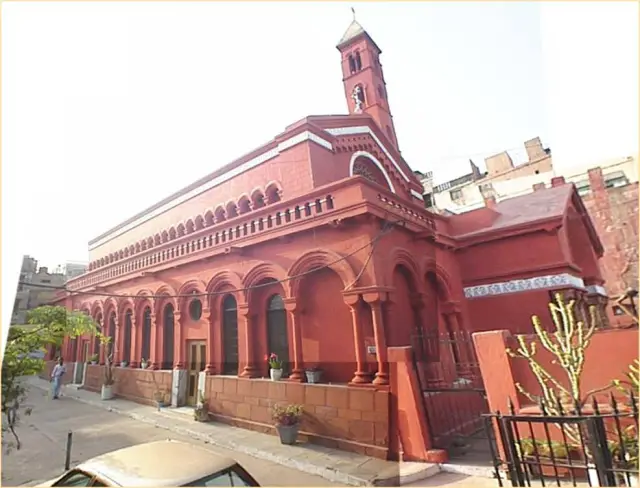
- Dedicated to SAINT STEPHEN, the St. Stephen’s church, is located in old Delhi near the Chandni Chowk area at Fatehpuri
- Designed in 1862, in gothic revival style, the church is an example of British colonial architecture in India. Today it makes a substantial contribution to the urban heritage of Delhi and has been provided urban heritage award for the year 1993
- The church today stands in congested old Delhi area with very tight access roads.
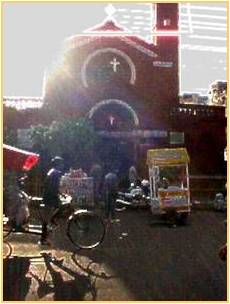
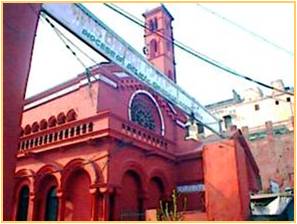
- Built in brick, painted with terracotta paint, with stripes of white, the church with its elegant entry and high bell tower definitely is a visual relief.
- The external form of the building however does not comply with the internal form. The externally visible tower is also inaccessible and purely ornamental.
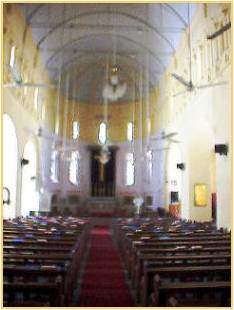
- Presenting an example of elegant British colonial architecture, the church has beautiful wooden interiors with shrine area in marble.
- The main hall of the church has a very high ceiling with baroque style of decoration and stained glass windows.
- The carvings, motives and icons of the church are typically British colonial in style.
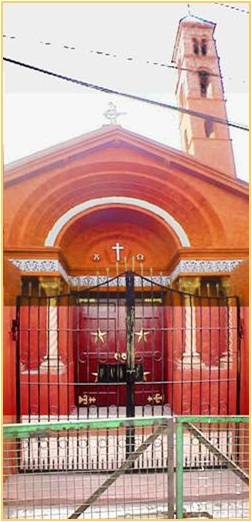
- The entry to the church happens through an iron bar gate, opening towards the road.
- The entry porch gives a recessed arch, with ornamented columns on both sides, and a red painted door, to mach with the red color of terracotta paint on the outer walls of the church.
- The entry is not much ornamented except than carvings on the columns and their capitals and some metal work on the door.
- The front wall of the entry hall is slope on the sides to give the effect of a sloping roof but it is actually in coffered RCC slab.
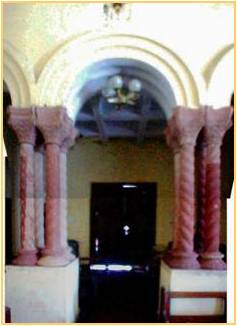
- Through this we enter the main hall of the church through a decorated arch with columns on either side.
- This colonnade is a set of three arches resting on two sets of pillars of four.
- The pillars are painted red in contrast to crème colored walls and white ceiling.
- The pillars are decorated with pilaster and ornamented capitals
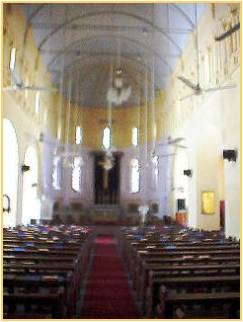
- The main hall has a high vault ceiling in RCC with ribs, which end in the shrine area in a semi- dome.
- The side walls have huge openings through arches to side wings which are lower in height and have RCC sloping roof with ribs.
- Light enters the hall through window lined on external walls of the side wings, which open up in the main hall through large arches. These windows are embedded in ornamental colonnade niches.
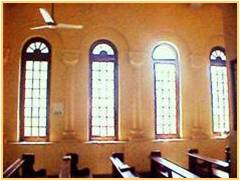
![[filefield-description]](https://www.archinomy.com/wp-content/uploads/central-hall_0.jpg)
- The central hall is higher than the side wings and the entrance lobby, hence has windows high on walls.
- It also has a round stained glass window on the entrance wall.
![[filefield-description]](https://www.archinomy.com/wp-content/uploads/wooden-furniture-1.jpg)
![[filefield-description]](https://www.archinomy.com/wp-content/uploads/wooden-furniture-2.jpg)
![[filefield-description]](https://www.archinomy.com/wp-content/uploads/wooden-furniture-3.jpg)
- The shrine is also well lit up with stained glass windows.
- The church thus is well lit from all possible points, together with high ribbed ceiling and stained glass windows reliving the essence of gothic period architecture.
- Mostly flat interiors of the church contrast with ornamental furniture and the shrine, stained glass windows and ornamented columns.
![[filefield-description]](https://www.archinomy.com/wp-content/uploads/stained-glass.jpg)
- Baptism happens near entry in highly ornamental wooden furniture.
- The orchestra mike and the priest’s platform are also highly ornamental pieces of furniture, built in marble.
![[filefield-description]](https://www.archinomy.com/wp-content/uploads/roof.jpg)
- The sloping roof of the entry lobby is fake as it is actually a flat roof.
- The front wall of the main hall also imitates sloping roof line but internally the roof is a semicircular vault.
![[filefield-description]](https://www.archinomy.com/wp-content/uploads/wall-1.jpg)
- The highly ornamental flat walls of the side wings hide the sloping roof, giving the essence of a flat terrace above
- The semi-octagonal form of the rear hides behind its flat high walls the semi-dome forming over the shrine
![[filefield-description]](https://www.archinomy.com/wp-content/uploads/wall-2.jpg)
ST. JAMES CHURCH, Kashmere Gate.
![[filefield-description]](https://www.archinomy.com/wp-content/uploads/st-james.jpg)
KASHMERE GATE
- Kashmere gate was the first place where the British settled. The troops encamped inside the city walls as there was a threat to their presence outside from the lawless Gujar tribes.
- This was quite unique keeping in mind that they had always dissociated with the walled city in earlier settlements by settling outside. The new settlements were in Kashmere gate and Daryaganj.
- Kashmere gate thus had all important residences, religious centres, administrative and judiciary functions as well as public places.
- In Kashmere gate evolved an unique hybrid of original Mughal pre-industrial and the European industrial architectural approach.
- This was reflected in the transformation and treatment of built form both in terms of plan and aesthetics, the treatment of formal and informal open spaces, institutions, administrative centres, military requirements of the invaders.
- Kashmere gate was hence the nucleus of all colonial development in and around Delhi and thus exhibits clearly the roots of transformation of the city from its Mughal base into an industrialized and westernized settlement.
- Many elite and spacious villas, relatively cut off from the densely populated and tightly packed buildings of the remainder of the city came up in kashmere gate.
- The first structures that came up were mostly of political and military importance, a small market, hospital, etc. Also came up.
![[filefield-description]](https://www.archinomy.com/wp-content/uploads/kashmere-gate.jpg)
HISTORY
- This anglican church was built by col. James skinner and is known as skinner’s church.
- It was completed in 1823, and was consecrated in 1836, by bishop daniel wilson of calcutta.
COL. JAMES SKINNER
- Skinner was an officer, of the maratha army under scindia, before he joined the british army in 1803.
- He built the church as a notion of thanks giving for narrowly escaping death in a maratha battlefield.
- Most of the records of the church were lost during the revolt of 1857 hence little is known about the details of its architect however, circumstantial evidence points to 2w officers of bengal engineers-maj.Robert smith who worked from the foundation to the cornice and and captain.D.Bude, in whose hands were entrusted most of the completion work. The credit for the classicism of the dome could go to captain. De bude.
![[filefield-description]](https://www.archinomy.com/wp-content/uploads/skinner.jpg)
INFLUENCES AND ANTECEDENTS…
This church is a fine example of the colonial classic architecture of the early part of the 19th century. The building is a subtle synthesis of classical and “late Mughal” styles.
Visually the classical look dominates but local influences can be observed on closer examination.
-The inner dome soffit floral pattern is a popular late Mughal motif
However designed primarily in the classical vocabulary, this building is typical of the first half of the 19th century when classicism was a fashionable expression for newly colonized Delhi and acted as an architectural trend setter.
![[filefield-description]](https://www.archinomy.com/wp-content/uploads/curve-roof.jpg)
The curve in the roof is reminiscent of coved Mughal ceilings.
![[filefield-description]](https://www.archinomy.com/wp-content/uploads/dome-church.jpg)
The church was initially painted pink, after which it underwent a series of changes in its exterior colour but at present it has been painted in a soft combination of off-white and yellow.
![[filefield-description]](https://www.archinomy.com/wp-content/uploads/plinth.jpg)
The plinth floral pattern is also late Mughal in style
![[filefield-description]](https://www.archinomy.com/wp-content/uploads/dome-st-james.jpg)
DOME OF ST JAMES CHURCH
This dome’s shape has been assimilated even though it is contradictory to the rules of classical grammar. The designers of the building seem to be well informed of neo-classical style of architecture. Thus have integrated this Florentine dome with the rest of the classical vocabulary
The dome is a pointed ribbed dome based on the Florence cathedral which initiated the entire movement of the renaissance.
The drum with circular openings also follow the same
Contribution of the military building tradition is seen in the sheer strength of construction and details like the foolproof ventilators on the roof
The picture of the church before mutiny shows vases, urns etc on the parapet walls.
All these qualities make the church very significant in the local sense of Delhi because they embody the culture of the time in which it was built
THE CHURCH COMPLEX
- It was set in a ten acre garden.
- There is a cemetery in the north of the church.
- The cemetery contained graves of important Delhi citizen and members of Skinner’s family
- Thomas Metcalf’s grave is in front of the Parish hall and William Frazer’s grave is in front of the church.
![[filefield-description]](https://www.archinomy.com/wp-content/uploads/church-complex.jpg)
At present the church complex consists of the following structures-
- Memorial cross
- Grave of William Frazer
- Skinner’s family graveyard closa
- Grave of Mary & William Forbes
- Grave of Rev. H. A. Love Day
- Grave of Elizabeth Mary
- Pensioner’s homes
- Staff Quarters
- Parish hall
- Grave of Julia Maria
- Grave of Thomas T.Metcalfe
- I.S.P.C.K Building
![[filefield-description]](https://www.archinomy.com/wp-content/uploads/ispc.jpg)
The I.S.P.C.K building on the west of the church
![[filefield-description]](https://www.archinomy.com/wp-content/uploads/cemetery.jpg)
Cemetry
![[filefield-description]](https://www.archinomy.com/wp-content/uploads/parish_hall.jpg)
The parish hall located on the north-east corner of the complex
The church Is placed centrally within a large compound and is oriented east-west. The original compound sloped towards the southern side. There are four gates at the four corners of the compound wall with driveways leading to the porticoes. This had a welcoming effect implying the very Christian principle of equally inviting every person to god’s home. However this quality was lost by later modifications in 1917 when the roads to the south-east and north-east were filled and the gateways were walled. Today there are two main entrances to the west of the church.
THE CHURCH BUILDING
The church began in 1823,was a centrally planned church, based on a Greek cross plan.
It consists of an altar in the eastern end and porticoes at all three other sides. The Greek cross plan was extended on two sides and a pointed “Florentine” dome surmounted by a heavy lantern covers the central octagonal space. The church was plastered to facilitate a uniform Neoclassical expression, through a two shade colour scheme that differentiated the classical elements from the plain surfaces.
![[filefield-description]](https://www.archinomy.com/wp-content/uploads/church-bldg-1.jpg)
ADDITIONS AND ALTERATIONS
During its third decade, (1856-1866) the church underwent numerous changes because of the repairs done on it after the damage caused on it by the Mutiny.
-Vestry was shifted from behind the altar to its south.
-The space behind the altar was incorporated into the church.
-Two stained glass windows (of European origin) were placed behind
the altar and one in the newly built vestry.
-In 1909 part of the original lantern supporting the ball and the cross fell though the inner dome. The lantern was later restored.
-in 1915 new ceilings were added to each side aisle.
-The interior column capitals were gilded with real gold.
-in 1938 the lady chapel was consecrated. This later addition explains the lack of a fourth stained glass window.
![[filefield-description]](https://www.archinomy.com/wp-content/uploads/church-bldg-2.jpg)
The East elevation of the church showing the three stained glass windows
ARCHITECTURE OF ST. JAMES CHURCH
The church falls in the category of central churches and the plan follows the form of the Greek cross or has a cruciform layout with an octagon at the center spreading out into the projections which contains
-the Altar at the eastern end,
-the Lady’s chapel besides the altar
-the entrances at the west,north and south![[filefield-description]](https://www.archinomy.com/wp-content/uploads/architecture-st-james.jpg)
An elongated effect is given to an essential round plan as the three arms of the cross are the porticos and fourth arm has been turned into the foyer.
![[filefield-description]](https://www.archinomy.com/wp-content/uploads/architecture-st-james-2.jpg)
ARCHITECTURAL ELEMENTS
The church exhibits considerable amount of ornamentation and entablature
-COLUMNS-
The porticoes have eight columns in all having a Tuscan appearance among which four are frontal columns. These columns are a combination of Tuscan and Doric orders.
Their arrangement is known as tetrastyle in classical terminology.
![[filefield-description]](https://www.archinomy.com/wp-content/uploads/elements.jpg)
![[filefield-description]](https://www.archinomy.com/wp-content/uploads/ionic-order.jpg)
Ionic order
![[filefield-description]](https://www.archinomy.com/wp-content/uploads/aoric-order.jpg)
tuscan order
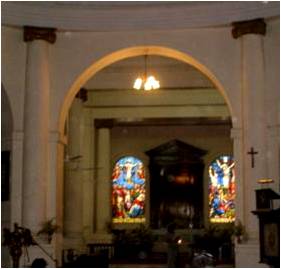
doric order
Internal columns-
The internal columns have ionic capitals that are gilded with gold.
The columns at the edges of the octagon merge with another set of eight ionic columns.
THE DOME
The dome rests on a high octagonal drum which spans the central space of the church.each side of the drum has a circular opening set within an arched panel.on the norht face this allows access to the space beteween the inner and the outer domes.
A composite moulding bands runs over the head of the arches.
At the top of the drum circular shaft placed on a pedestal and surmounted by an ionic capital painted gold.
This assemblage holds the cornice and the other mouldings over which sits the inner dome.
APPEARANCE
- The high outer dome of the building, could be seen from many parts of the city and formed a prominent landmark of the city.
- A religious building of such a monumental scale was perhaps meant to have a social impact.
![[filefield-description]](https://www.archinomy.com/wp-content/uploads/appearance.jpg)
SECTION THROUGH DOME
- The section through the dome shows the presence of two domes .
- The higher one is mainly to enhance the height and increase the significance of the church
- Due to this reason Sten Nelson quoted “It recalls late baroque Italy”
![[filefield-description]](https://www.archinomy.com/wp-content/uploads/dome-section.jpg)
THE CHURCH BUILDING TODAY
The church as seen today retains its classical late-mughal character both on the exterior as well as in the interiors. The building elements and spaces have been integrated into one consistent expression.
EXTERIOR
Plinth and foundation-
Entire building stands on a plain plinth of 70-80 cm height. The plinth and floor are like a large platform with the external walls set in. Four steps lead to the floor level today, originally it were five.
At the west portico the original plinth with the inverted floral motif still survives
The original church had foundations in rubble masonry .
But in later additions, standard English bricks have been used in the foundations.
Porticoes-
The church can be entered through porticoes on three sides.
Western portico is the main entrance.
The tetra-style porticoes are with Tuscan columns with a plain base and capital.
![[filefield-description]](https://www.archinomy.com/wp-content/uploads/plinth-2.jpg)
The plinth approximately 800-900 mm high
![[filefield-description]](https://www.archinomy.com/wp-content/uploads/western-portico.jpg)
The western portico main entrance
![[filefield-description]](https://www.archinomy.com/wp-content/uploads/southern-portico.jpg)
The southern portico
Walls
The walls are made of dressed stone laid by lime mortar and is duly plastered and painted.
The external walls over the plinth form a large expanse relieved by regular pilasters with equal rhythms.
Sitting on a moulded base the pilasters are rectangular in plan and taper to become narrower at the top, where they are surmounted by a capital. The pilasters are high, holding the entablature over which is the parapet.
![[filefield-description]](https://www.archinomy.com/wp-content/uploads/case-studies/2011/wall.jpg)
Niches
There are niches of various types found in the exterior wall surfaces
External niches are apsoidal, over which are arranged elliptical niches set within a rectangle.
Large arched niches appear on the southern wall next to the front portico and on the rear of the chapel where it forms a blind window.
![[filefield-description]](https://www.archinomy.com/wp-content/uploads/case-studies/2011/wall.jpg)
The rear of the church has a comparatively plain facade.
![[filefield-description]](https://www.archinomy.com/wp-content/uploads/wall-1_0.jpg)
The plain moulding that curves around the openings is very prominent.
![[filefield-description]](https://www.archinomy.com/wp-content/uploads/wall-2_0.jpg)
Openings– the doors and windows are larger than the standardsizes going up to a height of 3.3m.
DOORS
![[filefield-description]](https://www.archinomy.com/wp-content/uploads/door-1.jpg)
The main entrance door
Doors are of two types arched and trabeate.
The arched doors have a fixed semicircular fanlight above the normal door. eg. The main entrance door. All the main doors are double shutter doors.
-a wooden panel shutter on the inside and a wire mesh shutter on the outside.
The other external doors have a wooden louvered shutter on the outside.
WINDOWS
![[filefield-description]](https://www.archinomy.com/wp-content/uploads/case-studies/2009/door-2.jpg)
The bell tower door with a wooden louvered outside shutter
![[filefield-description]](https://www.archinomy.com/wp-content/uploads/window-1.jpg)
![[filefield-description]](https://www.archinomy.com/wp-content/uploads/window-2.jpg)
All windows are semicircular wooden windows with horizontal wooden louvers on them.
The semicircular top part of every window has a wooden ventilator
They are of an approximate height of about 3m.
the windows between the porticoes have different sills from other windows
The windows in the chapel are narrower and lack the louvered shutters.
![[filefield-description]](https://www.archinomy.com/wp-content/uploads/lintel-band.jpg)
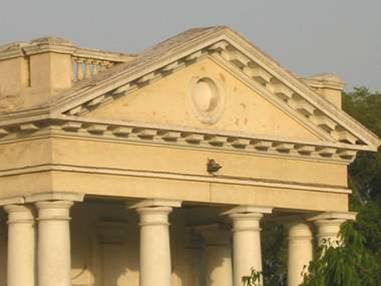
Stained glass windows-
- The stained glass windows were put up in the eastern end of the church. Two of these, one, the crucifixion and the other, the ascension are positioned on either side of the altar while the third in the vestry.
- It shows the terrified soldiers at Christ’s resurrection.
- Also one of the glass windows was in memory of Col. James Skinner.
![[filefield-description]](https://www.archinomy.com/wp-content/uploads/stained-glass-window_0.jpg)
Parapet-
The column and pilaster rhythms are extended to the parapet, which consciously harmonizes the various elements.
It is punctuated by low piers and walls.
The in between spaces is filled by balusters.
Garlands decorate rectangular portions of plain parapet over which were placed urns earlier.
![[filefield-description]](https://www.archinomy.com/wp-content/uploads/parapet.jpg)
THE LANTERN
The lantern on top of the outer dome is approximately 3m high .
It has a very decorative appearance like that of closed or curled petals
Placed on the octagonal top.
![[filefield-description]](https://www.archinomy.com/wp-content/uploads/lantern.jpg)
A view of the entablature supported on the heavy columns very essentially a Greek feature
![[filefield-description]](https://www.archinomy.com/wp-content/uploads/doric-column_0.jpg)
The Europeans now associated classical forms with what they called the civilized world.
The classical for Europeans essentially was Greek and Roman.
Hence, the classical architecture of Greece and Rome was strictly
bound by certain guidelines which gave a building its proportions.
Proportions were maintained by repeating a standard value arithmetically or multiples of that value in all components.
![[filefield-description]](https://www.archinomy.com/wp-content/uploads/entablature.jpg)
THE CEILING
The ceiling is made of sandstone supported on a series of I-girders stemming out radially from the octagonal dome.
There is an insulation gap of about one and a half feet between the roof and the ceiling which helps in maintaining a cool atmosphere inside the church.
The sandstone ceiling had circular ventilators at various junctures.
![[filefield-description]](https://www.archinomy.com/wp-content/uploads/ceiling.jpg)
Spatial organization
Section through St. James church
![[filefield-description]](https://www.archinomy.com/wp-content/uploads/section-st-james.jpg)
Section through the altar
![[filefield-description]](https://www.archinomy.com/wp-content/uploads/section-through-altar.jpg)
Section through southern and northern porticoes
![[filefield-description]](https://www.archinomy.com/wp-content/uploads/section-through-southern-northern.jpg)
Section through altar
![[filefield-description]](https://www.archinomy.com/wp-content/uploads/section-altar-2.jpg)
Interior spaces
Vestibules-
Four arms of the Greek cross plan form the vestibules on the four sides of the church.
On three sides they form the entrances, on the eastern side lie the chancel and the altar.
Differentiation between the vestibule and the main hall is articulated by means of fluted columns in the eastern and western arms.
These columns also help in reducing span for the riveted iron girders which support the roof.
Chapel-
Situated to the north of the altar it is modern in conception with most probably a coffered R.C.C. roof.
It has a white marble floor with a grey border.
Vestry-It has a flat roof and a terrazo floor.
![[filefield-description]](https://www.archinomy.com/wp-content/uploads/chapel.jpg)
The Chapel
Octagonal nave-
The centre of the building is a octagonal domed space enclosed by semi-circular arches. Each corner is defined by a column with a circular shaft placed on a plain pedestal and surmounted by an Ionic capital.
Niches and mouldings-
All internal columns are the classical Ionic type. In the main hall, plain Ionic columns placed on high pedestals mark the eight corners. The transition from the main hall into the sanctuary and the main entrance vestibule is marked by flouted Ionic columns placed on high pedestals.
![[filefield-description]](https://www.archinomy.com/wp-content/uploads/interiors.jpg)
![[filefield-description]](https://www.archinomy.com/wp-content/uploads/seating-arrangement.jpg)
![[filefield-description]](https://www.archinomy.com/wp-content/uploads/lectern.jpg)
![[filefield-description]](https://www.archinomy.com/wp-content/uploads/font.jpg)
![[filefield-description]](https://www.archinomy.com/wp-content/uploads/decorated-panel.jpg)
![[filefield-description]](https://www.archinomy.com/wp-content/uploads/pulpit.jpg)
![[filefield-description]](https://www.archinomy.com/wp-content/uploads/organ.jpg)
![[filefield-description]](https://www.archinomy.com/wp-content/uploads/interior-1.jpg)
- Pre-cement age building made of brick masonry and lime. The original church used “Mughal brick” masonry in lime mortar and finished with lime plaster. These are 75 cm thick. English bricks were used in additions and extensions. These are 60 cm thick. Terracotta has been used in the fabrication of balusters.
- Iron reinforcement has been used for the dome and the beams. The dome has iron flats inserted horizontally while I-section beams support the sandstone slabs on the roof. Wrought iron scrolls supported on a framework of riveted iron flats form a part of the lantern.
![[filefield-description]](https://www.archinomy.com/wp-content/uploads/case-studies/2011/sandstone.jpg)
![[filefield-description]](https://www.archinomy.com/wp-content/uploads/construction-material-1.jpg)
![[filefield-description]](https://www.archinomy.com/wp-content/uploads/construction-material-2_0.jpg)
The original foundation is made up of rubble masonry upto the plinth level, red sandstone has been used as structural material on the roofing and as finish for part of the floor. The rest of the floor is marble.
Wood has been used for the dado of the altar and railing of the chancel apart from doors and windows.
Glass has been used for the door and window panes. Three windows have stained glass.
Cement has been used in the extensions and additions with traditional whitewash and colour wash as the finishing medium. All woodwork and masonry have been painted with oil based finishes.
The dome consists of two shells, the inner and outer shells, making it a double dome.
The inner dome is hemispherical and has a circular skylight at the top, around which is a decorative lotus motif. Eight radially arranged walls buttress the inner dome.
Church in the twentieth century
- A new altar and raredos were erected and consecrated in 1943 to the memory of Raymond Grant Govan, a worshipper, benefactor and a member of the parish council.
- The old bell that had cracked was replaced in 1902 by Stanley Skinner.
- Electric lights and fans were installed for the first time in the church in1911.
- In 1970 the church boundry wall was taken up for rebuilding over the years as the old wall had been systematically damaged from outside for the value of iron spikes that the masonry contained.
- In 1977 the west verandah of the church was renovated and the north verandah was similarly done three years later.
- Later on iron grills were provided to the church windows.
- The stained glass windows were restored on world heritage day in 1996 by lt.Governor of Delhi as the patron of INTACH.
![[filefield-description]](https://www.archinomy.com/wp-content/uploads/church-20th-centrury.jpg)
CENTRAL BAPTIST CHURCH ![[filefield-description]](https://www.archinomy.com/wp-content/uploads/central-baptist-church.jpg)
Location plan of the church:
![[filefield-description]](https://www.archinomy.com/wp-content/uploads/location-of-church.jpg)
PLAN OF DELHI CITY
Chandni Chowk was once lined with beautiful fountains. But today the place is very crowded and congested. Chandni Chowk has the distinction of being perhaps the only trade market that also houses an equally amazing number of places of worship of all the prominent Indian religions. Hinduism, Islam, Sikhism, Christianity and Jainism exist side by sides in the 1.5 km. stretch between Fatehpuri Masjid to Red Fort.
Here more than seven Hindu and Jain temples, two Churches, three Mosques and two Gurudwaraas are present. Sri Digambar Jain Lal Mandir: Jama Masjid: Baba Baghel Singh Gauri Shankar temple Sunahari Masjid (Golden Mosque
HISTORY
The Baptist Missionary Society, London purchased a piece of land in 1792 near Red Fort where the Central Baptist Church was built during the reign of mughal king Alam Shah II. It was used by the local people as a place for worship.
But East India Company ordered to demolish it in 1857 due to the mutiny against Britishers. After a great deal of correspondence with the British government, a compensation of 30000/- and the present piece of land opposite Dariba Kalan was allotted to Baptist Missionary Society for the reconstruction of the church in 1858.
In 1860 Baptist Missionary Society reconstructed the church which stands today. It was designed in colonial style influenced by Kolkata and U.K. style of architecture.
It is still used as a church with the addition of a primary school in 1973.
FEATURES…
The Central Baptist church is one of the earliest churches in Delhi and a fine example of colonial architecture.
![[filefield-description]](https://www.archinomy.com/wp-content/uploads/feature-1_0.jpg)
THE SOUTH SIDE has a deep double height colonnaded porch supported on plain thick circular columns. This marks the entrance to the church.
The entrance to the church and the octastyle portico in front .
![[filefield-description]](https://www.archinomy.com/wp-content/uploads/feature-2_0.jpg)
THE ROOF made up of stone on iron beams has been re-laid. The ceiling has barrel vaults spanning across the building.
THE EAST & WEST SIDE have double height verandahs with semicircular arched openings .
![[filefield-description]](https://www.archinomy.com/wp-content/uploads/feature-3.jpg)
The semi circular arched openings and the verandah on the side.
![[filefield-description]](https://www.archinomy.com/wp-content/uploads/feature-4.jpg)
There are two skylights, octagonal in shape. Not sufficient light enters through these.
![[filefield-description]](https://www.archinomy.com/wp-content/uploads/feature-5.jpg)
The original height of the roof was 36 feet. But now it stands as 26 feet high roof structure.
GREEK REVIVAL STYLE < 1820-1860 > :
- Most have porticos (either entry or full-width) supported by prominent square or rounded columns, typically of Doric style, but also Ionic and Corinthian .
- Roof of low pitch
- Front door surrounded by transom lights above. (ancient Greek structures did not use arches)
- Window sashes most commonly with six-pane glazing
- Most Greek Revival frame houses were painted white.
![[filefield-description]](https://www.archinomy.com/wp-content/uploads/triglyph.jpg)
![[filefield-description]](https://www.archinomy.com/wp-content/uploads/greek-revival-style.jpg)
ARCHITECTURAL ELEMENTS…
Engaged column – A column attached to, or partly sunk into, a wall of pier. Also called an “applied column” or “attached column.”
![[filefield-description]](https://www.archinomy.com/wp-content/uploads/architectural-elements.jpg)
Columns inside the church are long and slender made of iron and belong to
Roman Doric order.
- Roman Doric columns usually have bases
- Roman columns are more slender
- Channeling (fluting) is altered or omitted
In this church there are two types of columns present belonging to two different orders of classical architecture.
![[filefield-description]](https://www.archinomy.com/wp-content/uploads/architectural-elements-2.jpg)
Columns on the outside belong to the Tuscan Order which is the simplest of all the orders characterized by:
- Unfluted columns
- Plain entablatures
- Unadorned capitals and bases
- Columns usually widely spaced and of short proportions
- A simplified Roman Doric.
FEATURES…
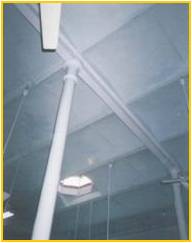
Barrel vault / Barrel roof:
![[filefield-description]](https://www.archinomy.com/wp-content/uploads/pediment.jpg)
Pediment
![[filefield-description]](https://www.archinomy.com/wp-content/uploads/triglyph_1.jpg)
Triglyph
Transom window
Central Baptist Church has an Octastyle portico.
Abacus
Metope
ENTABLATURE
Plan
Reflected ceiling Plan…
Elevations…
FRONT
SIDE

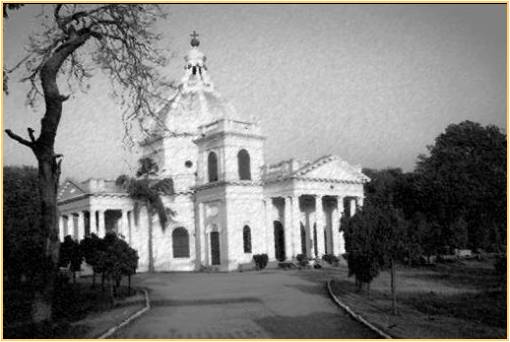
Quite a comprehensive
Quite a comprehensive case-study…very detailed..